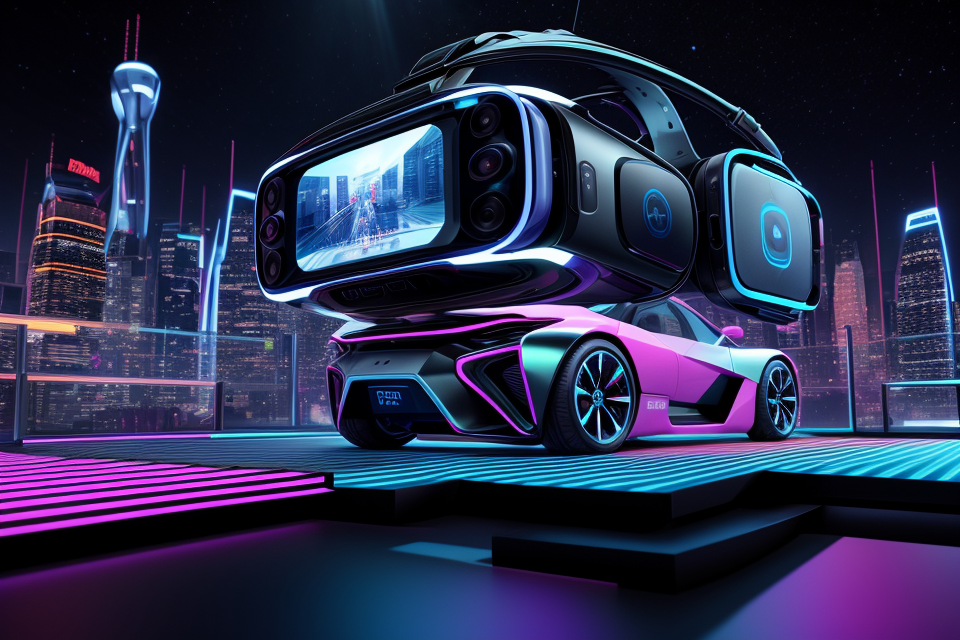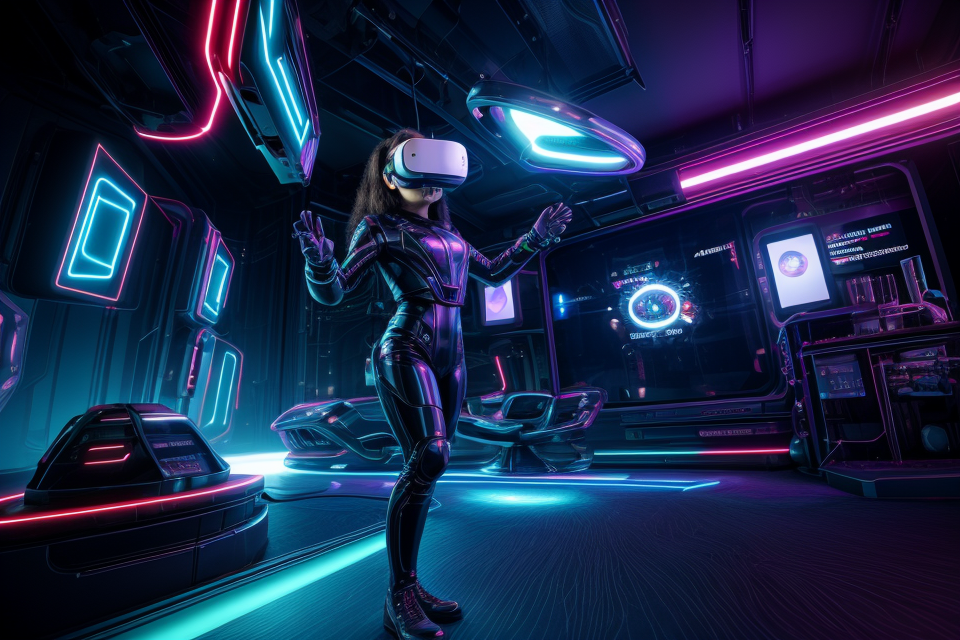
Virtual Reality (VR) has come a long way since its inception, offering immersive experiences that transport users to new worlds. With the rapid advancements in technology, it begs the question – how far will VR advance in the future? This topic delves into the possibilities and limitations of VR, exploring the potential for enhanced immersion, realism, and interactivity. From the integration of AI and machine learning to the development of haptic feedback systems, the future of VR is sure to bring forth new and exciting experiences. So, buckle up and join us on a journey to explore the potential of this cutting-edge technology.
The advancement of virtual reality (VR) technology is expected to continue at a rapid pace in the future. With the increasing availability of high-speed internet and powerful computing devices, VR is becoming more accessible and affordable for consumers. As VR technology improves, it is likely that we will see more realistic and immersive experiences, as well as greater interactivity and customization. Additionally, VR has the potential to revolutionize a wide range of industries, from entertainment and gaming to education and healthcare. As a result, it is likely that VR will continue to advance and become an increasingly integral part of our daily lives.
The Current State of Virtual Reality
The Evolution of VR Technology
- Early VR systems:
- Primitive head-mounted displays (HMDs)
- Low-resolution, limited field of view (FOV)
- Slow refresh rates and limited tracking capabilities
- Current VR systems:
- High-resolution OLED displays
- Wide FOV (100-120 degrees)
- Fast refresh rates (90 Hz and above)
- Advanced tracking systems (inside-out and outside-in)
- Six-degrees-of-freedom (6DoF) motion controllers
- VR hardware and software advancements:
- Reduced cost and increased accessibility
- Improved comfort and ergonomics
- Enhanced content creation tools and software development kits (SDKs)
- Artificial intelligence (AI) and machine learning (ML) integration
Applications of VR Today
- Gaming:
- High-quality, immersive gaming experiences
- Advanced haptic feedback and realistic motion controls
- Social interactions and multiplayer support
- Education:
- Immersive and interactive learning experiences
- Enhanced visualization of complex concepts
- Access to remote and historical locations
- Therapy:
- Virtual reality exposure therapy (VRET) for anxiety disorders
- Pain management and relaxation techniques
- Rehabilitation and physical therapy
- Training:
- Realistic and safe training environments
- Simulation of high-risk situations
- Skill development and performance analysis
- Entertainment:
- 360-degree video and immersive movies
- Virtual events and live performances
- Virtual worlds and social platforms
Factors Influencing Future Advancements
Technological Breakthroughs
Improved Hardware
- Advances in computing power, graphics processing units (GPUs), and central processing units (CPUs) will drive improvements in VR hardware.
- The development of lightweight, comfortable, and affordable VR headsets and other accessories will increase the accessibility of VR technology.
Enhanced Sensory Experiences
- The integration of haptic feedback, smell, and taste technologies into VR systems will enhance immersion and create more realistic experiences.
- The development of eye-tracking, brain-computer interface (BCI), and other biometric technologies will enable more intuitive and personalized interactions within virtual environments.
Advances in Artificial Intelligence
- AI algorithms will be crucial in creating dynamic, adaptive, and intelligent virtual worlds that respond to user actions and preferences.
- Machine learning techniques will be employed to improve content generation, scene rendering, and character behavior, resulting in more sophisticated and engaging VR experiences.
Market Demand and Investment
- The growing VR market, driven by gaming, entertainment, education, and other industries, will fuel continued investment in VR technology and content development.
- Industry giants and venture capitalists are already investing heavily in VR startups, fueling innovation and driving the growth of the VR ecosystem.
- As consumer needs and preferences evolve, VR technology will continue to advance to meet these demands, pushing the boundaries of what is possible in virtual environments.
The Future of Virtual Reality
Predictions for VR Advancements
Increased realism and immersion
As technology continues to advance, virtual reality is expected to become increasingly realistic and immersive. This means that users will be able to experience a more lifelike and believable virtual environment, with improved graphics, sound, and haptic feedback.
Seamless integration with the real world
Another prediction for the future of virtual reality is that it will become more seamlessly integrated with the real world. This could involve the use of augmented reality, where virtual objects and information are overlaid onto the real world, or the use of virtual reality for remote communication and collaboration.
More intuitive and natural user interfaces
Finally, it is expected that virtual reality will become more intuitive and natural to use. This could involve the use of new technologies such as brain-computer interfaces, which allow users to control virtual environments with their thoughts, or the development of more advanced and natural-feeling controllers and other input devices.
Challenges and Limitations
While there are many exciting predictions for the future of virtual reality, there are also several challenges and limitations that must be addressed.
Technological limitations
One of the main challenges facing virtual reality is technological limitations. While technology is advancing rapidly, there are still many technical hurdles to overcome, such as the need for more powerful and efficient computing systems, improved displays and sensors, and more sophisticated algorithms and simulations.
Cost and accessibility
Another challenge facing virtual reality is cost and accessibility. While the technology is becoming more affordable, it is still beyond the reach of many people, particularly in developing countries. This limits the potential market for virtual reality and could slow its adoption and development.
Ethical considerations
Finally, there are also ethical considerations to be addressed in the development of virtual reality. This includes issues such as privacy, security, and the potential for addiction or other negative effects on users. As virtual reality becomes more advanced and widespread, it will be important to ensure that it is developed and used in a responsible and ethical manner.
Implications of Advanced Virtual Reality
Positive Implications
- Expanded creative possibilities: Advanced virtual reality will enable the creation of more immersive and interactive experiences, opening up new possibilities for artists, filmmakers, and game developers. With improved graphics, haptic feedback, and realistic simulations, virtual reality will become an indispensable tool for storytelling and creative expression.
- New industries and job opportunities: As virtual reality technology advances, new industries and job opportunities will emerge. For instance, virtual reality medical training programs will enable medical students to practice surgical procedures in a risk-free environment. Virtual reality architectural visualization will revolutionize the way buildings are designed and marketed. Furthermore, virtual reality will create new opportunities for virtual tourism, socializing, and entertainment.
- Improved education and training: Virtual reality has already demonstrated its potential to enhance the learning experience. Advanced virtual reality will allow for more realistic simulations and hands-on training, enabling students to gain practical experience in various fields, such as aviation, military, and healthcare. Virtual reality can also facilitate distance learning, making education more accessible to people in remote areas.
Negative Implications
- Isolation and addiction: While virtual reality offers numerous benefits, there is a concern that it may lead to social isolation and addiction. People may spend more time in virtual environments, leading to decreased face-to-face interaction and neglect of real-life responsibilities. Moreover, the immersive nature of virtual reality can lead to addiction, with individuals becoming increasingly reliant on virtual experiences to satisfy their needs.
- Privacy concerns: As virtual reality becomes more advanced, privacy concerns will become more prominent. The collection and storage of personal data by virtual reality companies raise concerns about data breaches and cybersecurity. Moreover, virtual reality experiences may be used to manipulate users’ behavior and beliefs, raising ethical questions about the use of the technology.
- Unintended consequences: The widespread adoption of advanced virtual reality may have unintended consequences. For instance, virtual reality experiences may desensitize individuals to real-world violence, leading to increased aggression and violence. Furthermore, virtual reality may exacerbate existing social inequalities, as access to the technology may be limited to those who can afford it.
FAQs
1. How will virtual reality continue to evolve in the future?
Virtual reality technology is expected to continue advancing in the future, with improvements in areas such as graphics, audio, and sensory feedback. This will lead to more realistic and immersive experiences for users. Additionally, virtual reality systems may become more integrated with other technologies, such as augmented reality and artificial intelligence, to create even more sophisticated and interactive experiences.
2. What types of virtual reality experiences can we expect in the future?
In the future, virtual reality experiences may become even more realistic and immersive, allowing users to fully immerse themselves in virtual worlds. We may also see the development of new types of virtual reality experiences, such as virtual reality therapy, virtual reality education, and virtual reality entertainment. Additionally, virtual reality may become more integrated with other technologies, such as virtual reality gaming and virtual reality tourism.
3. How will virtual reality change the way we live and work in the future?
Virtual reality has the potential to change the way we live and work in a number of ways. For example, virtual reality could be used to create more efficient and effective ways of working, such as virtual meetings and virtual collaboration. It could also be used to enhance our ability to learn and explore new things, such as virtual field trips and virtual museum tours. Additionally, virtual reality could be used to provide new forms of entertainment and leisure activities, such as virtual reality gaming and virtual reality travel.
4. What are some of the challenges that virtual reality may face in the future?
One of the main challenges that virtual reality may face in the future is the development of more realistic and immersive experiences. This will require significant advances in areas such as graphics, audio, and sensory feedback. Additionally, virtual reality systems may need to become more user-friendly and accessible in order to reach a wider audience. Another challenge is the development of new business models and revenue streams for virtual reality, as the technology becomes more widely adopted.


